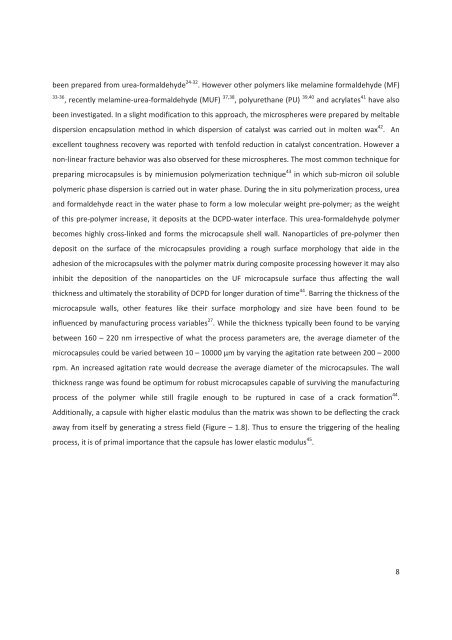4(%3)3 - Ecole nationale supérieure de chimie de Montpellier
4(%3)3 - Ecole nationale supérieure de chimie de Montpellier
4(%3)3 - Ecole nationale supérieure de chimie de Montpellier
Create successful ePaper yourself
Turn your PDF publications into a flip-book with our unique Google optimized e-Paper software.
een prepared from urea-formal<strong>de</strong>hy<strong>de</strong> 24-32 . However other polymers like melamine formal<strong>de</strong>hy<strong>de</strong> (MF)33-36 , recently melamine-urea-formal<strong>de</strong>hy<strong>de</strong> (MUF) 37,38 , polyurethane (PU) 39,40 and acrylates 41 have alsobeen investigated. In a slight modification to this approach, the microspheres were prepared by meltabledispersion encapsulation method in which dispersion of catalyst was carried out in molten wax 42 . Anexcellent toughness recovery was reported with tenfold reduction in catalyst concentration. However anon-linear fracture behavior was also observed for these microspheres. The most common technique forpreparing microcapsules is by miniemusion polymerization technique 43 in which sub-micron oil solublepolymeric phase dispersion is carried out in water phase. During the in situ polymerization process, ureaand formal<strong>de</strong>hy<strong>de</strong> react in the water phase to form a low molecular weight pre-polymer; as the weightof this pre-polymer increase, it <strong>de</strong>posits at the DCPD-water interface. This urea-formal<strong>de</strong>hy<strong>de</strong> polymerbecomes highly cross-linked and forms the microcapsule shell wall. Nanoparticles of pre-polymer then<strong>de</strong>posit on the surface of the microcapsules providing a rough surface morphology that ai<strong>de</strong> in theadhesion of the microcapsules with the polymer matrix during composite processing however it may alsoinhibit the <strong>de</strong>position of the nanoparticles on the UF microcapsule surface thus affecting the wallthickness and ultimately the storability of DCPD for longer duration of time 44 . Barring the thickness of themicrocapsule walls, other features like their surface morphology and size have been found to beinfluenced by manufacturing process variables 27 . While the thickness typically been found to be varyingbetween 160 – 220 nm irrespective of what the process parameters are, the average diameter of themicrocapsules could be varied between 10 – 10000 µm by varying the agitation rate between 200 – 2000rpm. An increased agitation rate would <strong>de</strong>crease the average diameter of the microcapsules. The wallthickness range was found be optimum for robust microcapsules capable of surviving the manufacturingprocess of the polymer while still fragile enough to be ruptured in case of a crack formation 44 .Additionally, a capsule with higher elastic modulus than the matrix was shown to be <strong>de</strong>flecting the crackaway from itself by generating a stress field (Figure – 1.8). Thus to ensure the triggering of the healingprocess, it is of primal importance that the capsule has lower elastic modulus 45 .8











